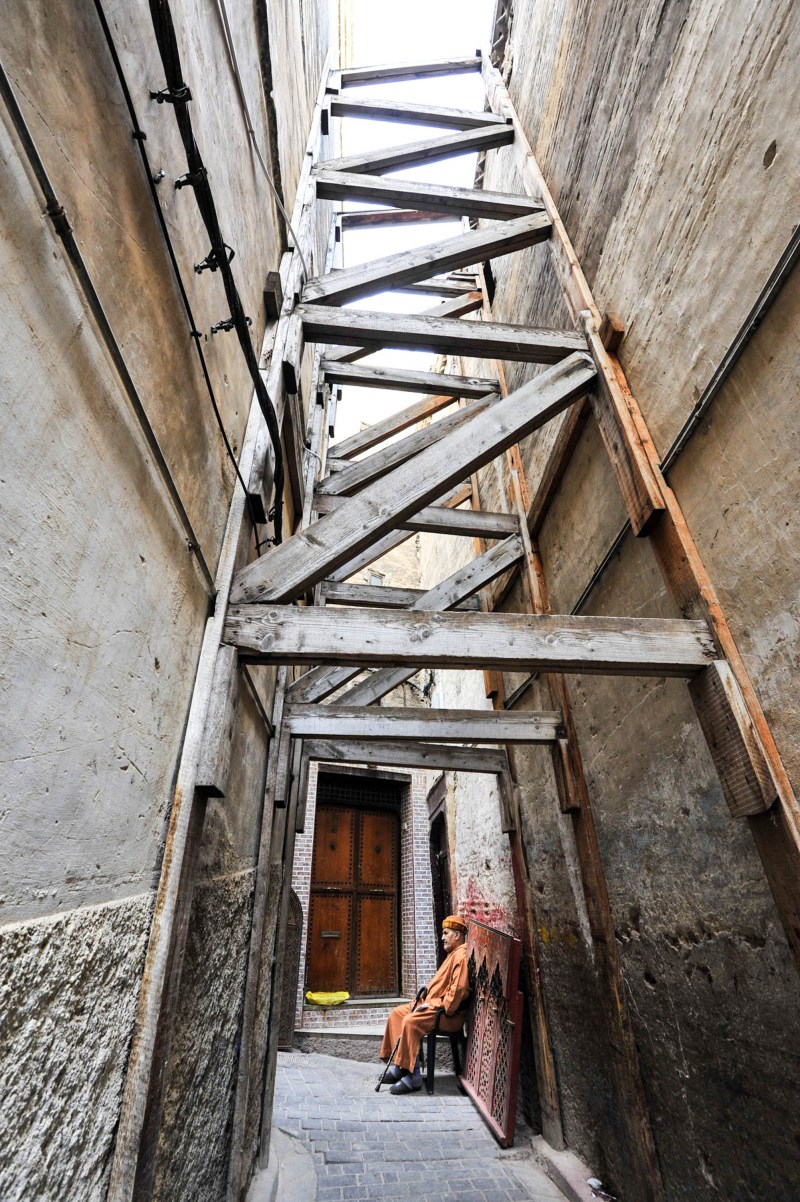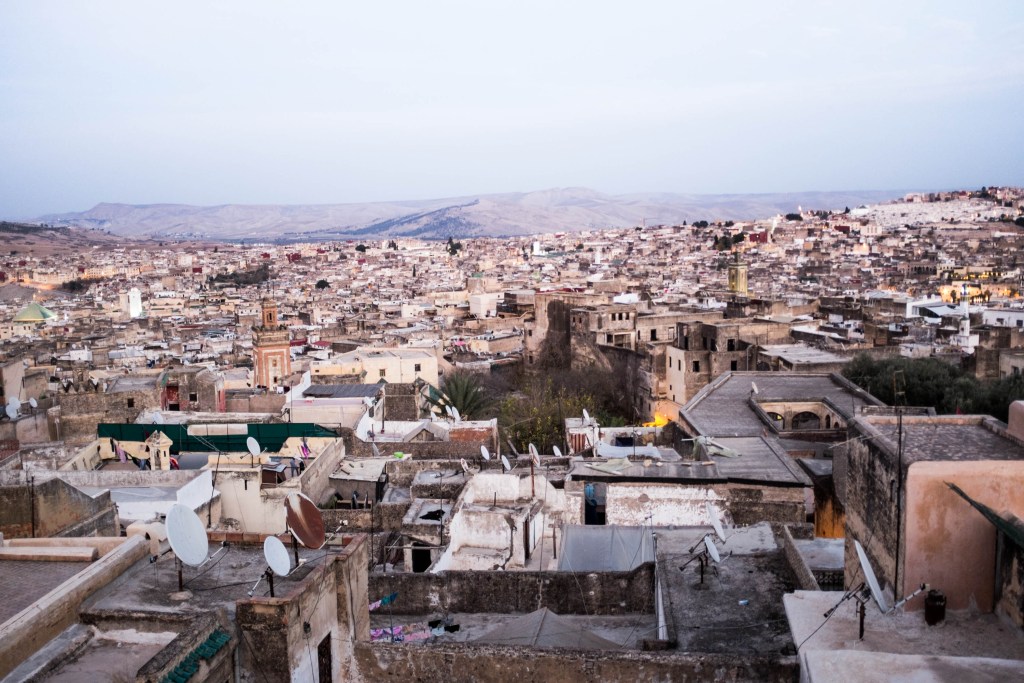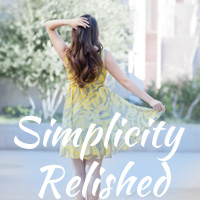I could wax poetic in a long exposé about this fascinating city with institutions dating back to the 9th century. I could, but I won’t– because I want more people to see this. So, despite my love-hate relationship with the list-form blog post, here it is. Because in the myriad places one might travel, Morocco is still surprisingly low on many bucket lists. Despite its rising popularity among savvy wanderers, there’s something mysterious about Morocco that makes it seem less accessible than it really is.
Despite my enthusiasm, I’ll offer up a few caveats: Fes is not an easy city to navigate all on one’s own, particularly if French and Arabic are an enigma. Even with some language ability, though, the fascinating portion of the city is the maze of its medina: walls and alleys wrapped around each other like intestines, except each doorway leads to new pathways that branch in and out as if in the 4th dimension.
In other words, without some help, you’ll probably get lost. Google Maps hasn’t exactly gotten the whole place figured out yet. But even with that risk, it is so worth it.

When to visit
Morocco is a desert, meaning the days are generally warm and the evenings are cool. We were told that the heat is nearly unbearable in the summer, but fall, winter and spring are lovely. We were there in January and it was pleasant to be in sweaters and long pants.
Where to stay
We loved our hotel in Fes: Riad Fes by Relais et Chateau. The riad is a traditional guest house, and you must seek to stay in one! There is usually a beautifully tiled atrium and rooms that branch off from the center.

10 Things You Must Do in Fes, Morocco
1) Wander through the souks in the morning.
The souks are the markets that open daily in the medina. There’s nothing quite like making your way through streams of locals about their daily business. Just stay out of the way– and ask permission before you take photographs! And then there are the super narrow alleys that are exhilarating to squeeze through.
A word to the wise: if you are not with a guide, you will likely lose your way. There’s nothing terrible about this, as Moroccans are friendly and will help you– but they might ask to be paid for it. If at all possible, go with a local who knows the souks. A compass is not enough!








2) Go hunting for mosaics.
Oh, the tiles of Morocco! They deserve an ode to themselves, truly. Whether it’s the floor of an atrium, the walls of a school or the stairs of an old home, the tiles are magnificent. You can certainly see some of this mosaic tradition at the Royal Alcazar in Seville, Spain, but it’s not quite the same as seeing it in context of daily Moroccan life.



3) Try the sweet things.
Moroccans love their sweets. Perhaps a too much; diabetes is a prevalent issue. But a little treat here and there can’t hurt, and you just have to try the local dates. If you’re feeling adventurous (and have a serious sweet tooth), buy a honey-glazed pastry. It might make your teeth hurt, but is worth the thrill.



4) Visit the tanneries.
These workshops are not for the faint of heart (or for vegans, quite frankly). But the tradition is magnificent– skins from dromedaries are brought in, cleaned, treated and dyed all in one location. It’s not the most pleasant smell, but you’ve probably smelled something worse at some point in your life. Bring some cash to purchase that bag, jacket, or pouf you were looking for; it’s always special to see exactly where something was made. Oh, and don’t forget to cut the vendor’s prices at least in half.



5) Stay at a riad.
There are riads at every price point, and I’m sure there are guides out there that will tell you exactly where they are. Our riad was the most luxurious place we stayed during our entire Moroccan journey, and it was worth it even just for the food and photographs. It’s amazing what the riad model says about local hospitality; guests deserve the best, whether it’s tea upon arrival, a hot meal made to order, or a room bedecked with mosaics.








6) Admire (and bargain for) local artisan crafts.
We stopped in at a wood shop that sold beautiful frames, mirrors and cabinetry. It was hard not to walk away without a sweet new piece for our walls, but we refrained. The artist had carved and hand-painted every last detail in his work, and was proud as could be.
Fes is Moroccan’s artisan capital, but not everything sold in Fes was made by a Moroccan artisan. Sadly the lure of cheap products from elsewhere has seeped into the souks, so if you do buy something, make sure it was made locally.







7) Dine Moroccan-style.
Our first few meals in Morocco were characterized by so much food we could hardly dream of eating more than half. Our guilty consciences forced us to ask the question: do Moroccans always eat this much? Quite the contrary, our guide informed us: it’s actually rude in Moroccan culture to finish all of the food– not that anyone is capable of it. The leftovers indicate that there was an abundance, and none of it goes to waste.
Each traditional Moroccan meal begins with a smattering of “salads”– beautiful cold dishes eaten with bread. Quite frankly, this is a sufficient meal for most appetites, but the entrees that follow are mounds of couscous and meat and vegetables. A plate of uncut fruit usually stands in as dessert, along with tea or coffee. I have no idea how people don’t fall asleep after lunch everyday.




8) Visit an old Islamic school.
There are several old schools in Fes, including the oldest university in the world. Unlike mosques, some of these schools are open to the public for a small fee, and are absolutely beautiful to behold. Even if they’re not open, sometimes you can peek in with impunity– a worthwhile snapshot!







9) Check out the ceramics studios.
Apprenticeship is still alive and well in the ceramic making studios of Fes. Young men come to train for years, starting with menial jobs to aid the artisans, and gradually learning the art of moulding, painting, cutting and designing ceramic tiles for pottery and mosaics. The backs of mosaics are astounding: the amount of work that goes into making even a small piece requires hours of effort and years of training.





10) Relish the details.
What I loved most about Fes was the incredible mix of whimsy and fierce. There’s nothing quite like it: art is everywhere, children run and laugh in the medina, while the deep-set eyes of an old man look on, and the structures of tradition continue to reign. Not all of this can be captured on camera, but Fes is still a sight to behold.





Our favorite resources:
- Morocco: Insight Guides (my favorite comprehensive guide book series)
- The Food of Morocco: authentic cookbook for Moroccan cuisine
- A House in Fez: Building a Life in the Ancient Heart of Morocco


